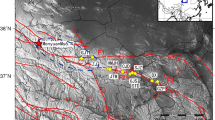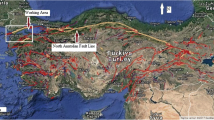Abstract
Radon and mercury concentrations were measured in 10 fault gas profiles in Generalized Haiyuan Fault. This paper aims to predetermine the potential seismic risk in different segments of the fault zone from the perspective of geochemistry. The background value and anomaly threshold were adopted and synthesized using the maximum value method and average method to calculate concentration intensity values of radon and mercury. Fault soil gas mercury and radon concentrations show a decreasing gradient from NW to SE indicating evident segmentation. Higher values are mostly distributed in the Maomao Mountain–Tiger Mountain fault and Jingtai area. Combined with the seismotectonic background of historical and recent earthquakes and the spatial distribution characteristics of b-values, the fault soil gas concentration intensity shows a close correlation with earthquake activity within the fault zone. Concentrations of fault gas are higher and the b-value lower in areas of strong seismic activity, and regions with weak seismic activity correspond to lower fault gas concentrations and higher b-values. It is thus considered that the Jingtai area may be more dangerous than the other areas. This paper could provide vital background information for earthquake prediction in the Generalized Haiyuan Fault Zone.






Similar content being viewed by others
References
Amitrano D (2003) Brittle-ductile transition and associated seismicity: experimental and numerical studies and relationship with the b value. J Geophy Res Atmos 108(B1):233–236. doi:10.1029/2001JB000680
Baykara O, İnceöz M, Doğru M, Aksoy E, Külahcı F (2009) Soil radon monitoring and anomalies in East Anatolian Fault System(Turkey). J Radioanal Nucl Chem 279(1):159–164
Ciotoli G, Guerra M, Lombardi S, Vittori E (1998) Soil gas survey for tracing seismogenic faults: a case study in the Fucino Basin, central Italy. J Geophys Res Solid Earth 103(B10):23781–23794. doi:10.1029/98JB01553
Ciotoli G, Etiope G, Guerra M, Lombardi S (1999) The detection of concealed faults in the Ofanto Basin using the correlation between soil-gas fracture surveys. Tectonophysics 301(3):321–332. doi:10.1016/S0040-1951(98)00220-0
Ciotoli G, Lombardi S, Annunziatellis A (2007) Geostatistical analysis of soil gas data in a high seismic intermontane basin: Fucino Plain, central Italy. J Geophys Res Atmos 112(112):2637–2655. doi:10.1029/2005JB004044
Du YJ, Ma J, Li JG (1989) Interaction and stability of en echelon crack. Acta Geophys Sin 32(suppl 1):218–231 (in Chinese)
Duvall AR, Clark MK (2010) Dissipation of fast strike-slip faulting within and beyond northeastern Tibet. Transl World Seismol 38(3):223–226
Einarsson P, Theodorsson P, Hjartardottir AR, Guojonsson GI (2008) Radon changes associated with the earthquake sequence in June 2000 in the South Iceland seismic zone. Pure Appl Geophy 165(1):63–74
Fu CC, Yang TF, Du J, Walia V, Chen YG et al (2008) Variations of helium and radon concentrations in soil gases from an active fault zone in southern Taiwan. Radiat Meas 43(1):S348–S352. doi:10.1016/j.radmeas.2008.03.035
Hauksson E, Goddard JG (1981) Radon earthquake precursor studies in Iceland. J Geophys Res Atmos 86(B8):7037–7054. doi:10.1029/JB086iB08p07037
He WG, Yuan DY, Liu BC (1994) Study on the segmentation of Laohushan Fault Zone. Northwest Seismol J 16:66–72 (in Chinese)
Igarashi G, Wakita H (1990) Groundwater radon anomalies associated with earthquakes. Tectonophysics 180(2–4):237–254
Igarashi G, Saeki S, Takahata N, Sumikawa K, Tasaka S (1995) Ground-water radon anomaly before the kobe earthquake in Japan. Science 269(5220):60–61
King CY, King BS, Evans WC, Zhang W (1996) Spatial radon anomalies on active faults in California. Appl Geochem 11(4):497–510
Kumar A, Walia V, Singh S, Bajwa BS, Mahajan S (2012) Earthquake precursory studies at Amritsar Punjab, India using radon measurement techniques. Int J Phys Sci 7(42):5669–5677
Li CH, Su HJ, Zhang H, Zhou HL (2016) Correlation between the spatial distribution of radon anomalies and fault activity in the northern margin of West Qinling Fault Zone, Central China. J Radioanal Nucl Chem 308(2):679–686. doi:10.1007/s10967-015-4504-8
Liu BC, Lu TY, Yuan DY (1994a) Study on the division and correlation of quaternary stratain in Laohushan active fault area, JingTai county, GanSu. Northwest Seismol J 16:54–62 (in Chinese)
Liu XF, Liu BC, Lu TY (1994b) The research on the Laohushan active fault.South China. J Seismol 14:10–16 (in Chinese)
Liu J, Xu XW, Li YF (2007) On the completeness of paleoseismic records of strike-slip fault:an example from the Laohushan segment of the Haiyuan fault in Gansu, China, with a discussion of several problems in the paleoearthquake study. Geol Bull China 26:650–660 (in Chinese)
Lombardi S, Voltattorni N (2010) Rn, He and CO2 soil gas geochemistry for the study of active and inactive faults. Appl Geochem 25(8):1206–1220
Ma J, Guo YS (2014) Accelerated synergism prior to fault instability:evidnce from laboratory experiments and an earthquake case. Seismol Geol 36:547–561 (in Chinese)
Ma J, Sherman SI, Guo YS (2012) Identification of meta-instable stess state based on experimental study of evolution of the temperature field during stick-slip instability on a 5° bending fault. Sci China (Ser D) 55:869–881 (in Chinese)
Phuong NK, Harijoko A, Itoi R, Unoki Y et al (2012) Water geochemistry and soil gas survey at Ungaran geothermal field, central Java, Indonesia. J Volcanol Geotherm Res s 229–230(6):23–33. doi:10.1016/j.jvolgeores.2012.04.004
Pizzino L, Burrato P, Quattrocchi F, Valensise G (2004) Geochemical signatures of large active faults:the example of the February 5th 1783, Calabrian Earthquake (Southern Italy). J Seismol 8(3):363–380
Richon P, Sabroux JC, Halbwachs M, Vandemeulebrouck J, Poussielgue N, Tabbagh J, Punongbayan R (2003) Radon anomaly in the soil of Taal volcano, the Philippines: a likely precursor of the M 7.1 Mindoro earthquake (1994). Geophys Res Lett 30(9):319–338
Scholz CH (1968) The frequency-magnitude relation of microfracturing in rock and its relation to earthquakes. Bull Seismol Soc Am 58:399–415
Scholz CH, Sykes LR, Aggarwal YP (1973) Earthquake prediction:a physical basis. Science 181(4102):803–810. doi:10.1126/science.181.4102.803
Schorlemmer D, Wiemer S, Wyss M (2005) Variations in earthquake-size distribution across different stress regimes. Nature 437(7058):539–542
Segovia N, Seidel JL, Monnin M (1987) Variations of radon in soils induced by external factors. J Radioanal Nucl Chem 119(3):199–209
Shi YL, Zhang BA, Wang XB (1990) The fault gases of large fault on the northern fringe of Qinling mountain and its earthquake risk. Northwest Seismol J 12:22–26 (in Chinese)
Singh M, Kumar M, Jain RK, Chatrath RP (1999) Radon in ground water related to seismic events. Radiat Meas 30(4):465–469
Su HJ, Zhang H, Li CH, Zhou HL (2013) Geochemical features of fault gas on northern margin fault of Xiqinling and its seismic hazard analysis. China Earthq Eng J 35(3):671–676 (in Chinese)
Tarakçı M, Harmanşah C, Saç MM, İçhedef M (2014) Investigation of the relationships between seismic activities and radon level in Western Turkey. App Radiat Isotopes 83(1):12–17
Teng Ta-Liang (1980) Some recent studies on ground water radon content as an earthquake precursor. J Geophys Res Atmos 85(B6):3089–3099
Toutain JP, Baubron JC (1999) Gas geochemistry and seismotectonics: a review. Tectonophysics 304(1):1–27. doi:10.1016/S0040-1951(98)00295-9
Virk HS, Sharma VWAK (2013) Radon precursory signal of Chamba earthquake. Currentence 69(5):452–454
Virk HS, Singh B (1994) Radon recording of Uttarkashi earthquake. Geophys Res Lett 21:737–740
Virk HS, Walia V (2001) A critical analysis of radon emanometry data recorded at Palampur and Dalhousie for earthquake prediction studies in N-W Himalaya. Humanika 34:243–256 (Spl.Vol.1&2)
Virk HS, Walia V, Sharma AK (1995) Radon precursory signal of Chamba earthquake. Currentence 69:452–454
Virk HS, Walia V, Kumar N (2001) Helium/radon precursory anomalies of Chamoli earthquake, Garhwal Himalaya, India. J Geodyn 31(2):201–210
Walia V, Virk HS, Bajwa BS, Sharma N (2003) Relationships between radon anomalies and seismic parameters in N-W Himalaya, India. Radiat Meas 36(1):393–396
Walia V, Virk HS, Yang TF, Mahajan S, Walia M, Bajwa BS et al (2005a) Earthquake prediction studies using radon as a precursor in N-w Himalayas, India: a case study. Terr Atmos Ocean Sci 16(4):775–804
Walia V, Su TC, Fu CC, Yang TF (2005b) Spatial variations of radon and helium concentration in soil gas across Shan-Chiao fault, Northern Taiwan. Radiat Meas 40:513–516
Walia V, Virk HS, Bajwa BS (2006) Radon precursory signals for some earthquakes of magnitude >5 occurred in N-W Himalaya. Pure appl Geophys 163(4):711–721
Walia V, Mahajan S, Kumar A, Singh S, Bajwa BS, Dhar S, Yang TF (2008) Fault delineation study using soilegas method in the Dharamsala area, NW Hima-layas, India. Radiat Meas 43:S337–S342
Walia V, Yang TT, Lin SJ, Kumar A, Fu CC, Chiu JM, Chang HH, Wen KL, Chen CH (2013a) Temporal variation of soil gas compositions for earthquake surveillance in Taiwan. Radiat Meas 50:154–159
Walia V, Yang TT, Lin SJ, Kumar A, Fu CC, Chiu JM, Chang HH, Wen KL, Chen CH (2013b) Temporal variation of soil gas compositions for earthquake surveillance in Taiwan. Radiat Meas 50:154–159
Wang C, Li X, Wei B (1991) Applications of measurement of fracture gases in seismological sciences (in Chinese). Seismol Press Beijing 11:497–510
Wang X, Li Y, Du JG, Zhou XC (2013) Correlations between radon in soil gas and the activity of seismogenic faults in the Tangshan area, North China. Radiat Meas 60:8–14
Wiemer S, Schorlemmer DALM (2007) An asperity-based likelihood model for California. Seismol Res Lett 8:134–140
Wiemer S, Wyss M (2000) Minimum magnitude of completeness in earthquake catalogs: examples from Alaska, the Western US And Japan. Bull Seismol Soc Am 90(4):859–869
Ye Q, Singh RP, He A, Ji S, Liu C (2015) Characteristic behavior of water radon associated with Wenchuan and Lushan earthquakes along Longmenshan fault. Radiat Meas 76:44–53. doi:10.1016/j.radmeas.2015.04.001
Yuan DY, Liu BC, Lu TY (1996) The cumulative slip deficit of displacements and significance of segmentation along the Maomaoshan Fault Zone. Northwest Seismol J 18:59–67 (in Chinese)
Acknowledgments
The authors are grateful to anonymous reviewers. This work is supported by the basic R&D fund of the Institute of Earthquake Science, China Earthquake Administration (CEA) (Grant 2013IESLZ04) and Spark Program of China Earthquake Administration (Grant XH15043).
Author information
Authors and Affiliations
Corresponding author
Rights and permissions
About this article
Cite this article
Zhou, H., Su, H., Zhang, H. et al. Correlations between soil gas and seismic activity in the Generalized Haiyuan Fault Zone, north-central China. Nat Hazards 85, 763–776 (2017). https://doi.org/10.1007/s11069-016-2603-7
Received:
Accepted:
Published:
Issue Date:
DOI: https://doi.org/10.1007/s11069-016-2603-7




